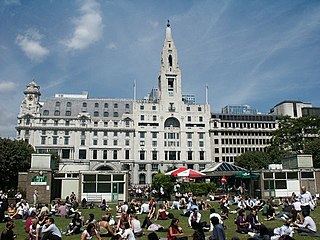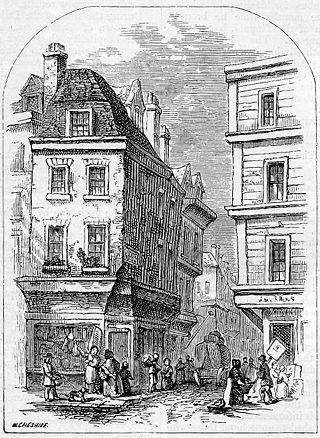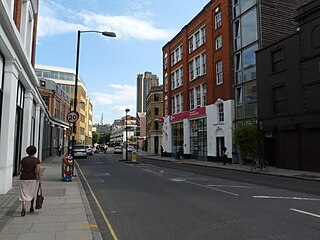
Clerkenwell is an area of central London, England.

Finsbury is a district of Central London, forming the southeastern part of the London Borough of Islington. It borders the City of London.

The Barbican Estate, or Barbican, is a residential complex of around 2,000 flats, maisonettes, and houses in central London, England, within the City of London. It is in an area once devastated by World War II bombings and densely populated by financial institutions, 1.4 miles (2.2 km) north east of Charing Cross. Originally built as rental housing for middle and upper-middle-class professionals, it remains an upmarket residential estate. It contains, or is adjacent to, the Barbican Arts Centre, the Museum of London, the Guildhall School of Music and Drama, the Barbican public library, the City of London School for Girls and a YMCA, forming the Barbican Complex.
Aldersgate is a Ward of the City of London, England, named after one of the northern gates in the London Wall which once enclosed the City.

Cripplegate was a gate in the London Wall which once enclosed the City of London, England.

Moorfields was an open space, partly in the City of London, lying adjacent to – and outside – its northern wall, near the eponymous Moorgate. It was known for its marshy conditions, the result of the defensive wall acting as a dam, impeding the flow of the River Walbrook and its tributaries.

Farringdon Road is a road in Clerkenwell, London.

St Giles-without-Cripplegate is an Anglican church in the City of London, located on Fore Street within the modern Barbican complex. When built it stood without the city wall, near the Cripplegate. The church is dedicated to St Giles, patron saint of handicapped and infirm people of many different kinds. It is one of the few medieval churches left in the City of London, having survived the Great Fire of 1666.

Until the early 19th century, Grub Street was a street close to London's impoverished Moorfields district that ran from Fore Street east of St Giles-without-Cripplegate north to Chiswell Street. It was pierced along its length with narrow entrances to alleys and courts, many of which retained the names of early signboards. Its bohemian society was set amidst the impoverished neighbourhood's low-rent dosshouses, brothels and coffeehouses.

St Luke's is an area in London, England and is located in the London Borough of Islington. It lies just north of the border with the City of London near the Barbican Estate, and the Clerkenwell and Shoreditch areas.

St Luke's is a historic Anglican church building in central London, and in the London Borough of Islington. It served as a parish church from 1733 to 1959. It was designed by John James and Nicholas Hawksmoor, and is a Grade I listed building.

Coleman Street is one of the 25 ancient wards of the City of London, England, and lies on the City's northern boundary with the London Borough of Islington.

United House Developments is a property development and housebuilding company based in Southampton Street, London. It is active in the construction of social housing, urban regeneration, refurbishment and Public Private Partnerships (PPP).

St James' Church, Islington, is a parish church in the inner London borough of Islington. It is located on Prebend Street between Essex Road and the New North Road. The parish is bounded by Essex Road between the New North Road and Upper Street, Upper Street to The Angel, Islington, City Road to Wharf Road, Wharf Road to the Regent's Canal, and the Regent's Canal to the New North Road.

Chiswell Street is in the London Borough of Islington. It includes several buildings listed by Historic England.

Silk Street is a street in the City of London, England. It runs north–south, and then west–east, from the junction with Beech Street (west), Chiswell Street (east) and Whitecross Street, to Moor Lane.

Golden Lane, originally known as Goldeslane or Goldyng Lane, then Golding Lane, is a street in the City of London, England, that runs north–south, between Old Street in the north, and Beech Street in the south. It dates back to at least 1274 and was the site of Edward Alleyn's Fortune Theatre that was built in 1600. The street was almost completely destroyed by bombing during the Second World War before being rebuilt in the post-war era.

Beech Street is a street in the City of London, England. It was formerly known as Beech Lane and was named after Nicholas de la Beche, a lieutenant of the Tower of London in the reign of Edward III in the 14th century.

Fore Street is a street in the City of London, England, near the Barbican Centre. It runs from Wood Street to Fore Street Avenue and is joined by Moor Lane on its north side. The street was extensively damaged by Nazi bombing during World War II and, following later development, nothing now remains of its original buildings other than St Giles-without-Cripplegate, which is a short distance away from the modern street.

Whitecross Street Prison was a debtors' prison in London, England. It was built between 1813–15 to ease overcrowding at Newgate Prison and closed in 1870, when all of the prisoners were transferred to the newly built Holloway Prison.






















